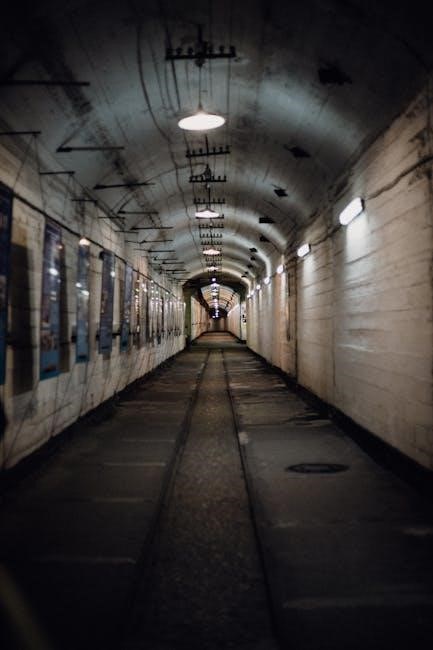Colson Whitehead: Author Overview
Colson Whitehead‚ a #1 New York Times bestselling author‚ is celebrated for The Underground Railroad‚ which won the 2016 Pulitzer Prize in Fiction and the National Book Award. His impressive body of work includes nine books of fiction and non-fiction. He is also a recipient of MacArthur and Guggenheim Fellowships. Whitehead’s literary prowess weaves sagas of America‚ exploring brutal histories and unfulfilled promises.
Cora’s Journey: A Slave’s Adventures
Cora‚ a slave on a Georgia cotton plantation‚ faces a life of hell‚ ostracized even by her fellow Africans. As she enters womanhood‚ greater pain awaits. When Caesar‚ a recent arrival from Virginia‚ tells her about the Underground Railroad‚ they decide to escape. Their plan goes awry when Cora kills a white boy trying to capture her. They manage to find a station and head north‚ embarking on a harrowing flight.
In Colson Whitehead’s ingenious conception‚ the Underground Railroad is an actual railroad with engineers and conductors operating a secret network of tracks and tunnels beneath the Southern soil. Cora encounters strange‚ yet familiar iterations of her world at each stop‚ much like Gulliver. Her first train takes her and Caesar to South Carolina‚ where they live more like free people‚ setting a pattern of storytelling through different states.
Throughout her escape‚ Cora learns to trust her instincts‚ rely on her strength‚ and fight for her freedom. She encounters different worlds at each stage‚ as Whitehead recreates the terrors for black people in the pre-Civil War era. Cora’s journey is both a kinetic adventure and a powerful meditation on shared history‚ showcasing her ferocious will to escape bondage.

Historical Context: Antebellum South
The Antebellum South‚ the setting for The Underground Railroad‚ was a period of immense social and economic disparity‚ deeply rooted in the institution of slavery. This era‚ preceding the Civil War‚ saw the Southern states heavily reliant on agriculture‚ particularly cotton‚ which fueled their economy. Slavery was not just an economic system but also a deeply ingrained social structure‚ shaping every aspect of life for both white and black populations. The lives of enslaved people were marked by brutality‚ dehumanization‚ and constant fear. They were subjected to forced labor‚ physical abuse‚ and the denial of basic human rights‚ including education‚ family‚ and personal autonomy.
The legal system reinforced this oppression‚ with laws designed to maintain the slave system and punish those who resisted or attempted to escape. White society‚ particularly the planter elite‚ justified slavery through a combination of economic necessity and racial ideology‚ arguing that black people were inherently inferior and suited for servitude. This period was also characterized by growing tensions between the North and South‚ as abolitionist movements gained momentum‚ challenging the morality and legality of slavery. The Underground Railroad‚ a network of secret routes and safe houses‚ emerged as a direct response to the injustices of the Antebellum South‚ offering a glimmer of hope for enslaved people seeking freedom. The Fugitive Slave Act further intensified the conflict‚ making it a federal crime to assist runaway slaves‚ thus highlighting the deep divisions within the nation.
The Underground Railroad: Literal Interpretation
Colson Whitehead’s ingenious reimagining of the Underground Railroad transforms the historical network of secret routes and safe houses into a literal railroad system‚ complete with tracks‚ tunnels‚ engineers‚ and conductors operating beneath the Southern soil. This is not merely a metaphor‚ but a fully realized subterranean railway that serves as the physical means of escape for Cora and other enslaved people seeking freedom. The literal interpretation amplifies the dangers and uncertainties of the journey‚ as Cora embarks on a harrowing flight from one state to the next‚ encountering different iterations of her world at each stop.
The physical railroad underscores the desperation and determination of those who risked their lives for a chance at liberty; Each station along the Underground Railroad represents a different facet of American society‚ exposing the unique terrors and challenges faced by black people in the pre-Civil War era. As Cora travels through these various states‚ she confronts different forms of oppression‚ resilience‚ and resistance. Whitehead’s literal depiction allows him to explore the complex themes of freedom‚ identity‚ and the enduring legacy of slavery in a powerful and visceral way. This reimagining also emphasizes the ingenuity and bravery of those who created and maintained the Underground Railroad‚ highlighting their commitment to helping others escape the horrors of bondage. The physical presence of the railroad becomes a symbol of hope and possibility in a world defined by cruelty and injustice.

Themes in The Underground Railroad
Colson Whitehead’s The Underground Railroad delves into profound themes of freedom‚ identity‚ and the enduring legacy of slavery. The novel explores the multifaceted nature of freedom‚ portraying it not as a singular achievement but as an ongoing struggle. Cora’s journey along the Underground Railroad symbolizes the pursuit of physical liberation and the quest for inner emancipation from the psychological scars of slavery. Identity is another central theme‚ as Cora grapples with her sense of self in a world that seeks to dehumanize her. Her interactions with different communities along the railroad force her to confront various aspects of her identity as a black woman in America.
The novel also confronts the lasting impact of slavery on individuals and society. Whitehead portrays the institution’s brutality and its pervasive influence on every aspect of American life. Through Cora’s experiences‚ the novel examines the ways in which slavery continues to shape the present‚ highlighting the unfulfilled promises of equality and justice. Furthermore‚ The Underground Railroad explores the themes of resilience and resistance. Despite facing unimaginable horrors‚ Cora demonstrates remarkable strength and determination in her fight for survival. The novel celebrates the courage and ingenuity of those who resisted slavery‚ both through acts of rebellion and everyday acts of defiance. By interweaving these themes‚ Whitehead creates a powerful and thought-provoking narrative that challenges readers to confront the complexities of American history and the ongoing struggle for racial equality.

Awards and Recognition for The Underground Railroad
The Underground Railroad by Colson Whitehead has garnered widespread acclaim and numerous prestigious awards‚ solidifying its place as a significant work of American literature. Among its most notable accolades is the 2016 Pulitzer Prize for Fiction‚ recognizing the novel’s powerful storytelling‚ historical insight‚ and profound exploration of themes related to slavery and freedom. The National Book Award for Fiction was also bestowed upon The Underground Railroad in 2016‚ further cementing its status as a literary masterpiece. These awards highlight the novel’s exceptional literary merit and its impact on contemporary readers.
In addition to these major awards‚ The Underground Railroad was named one of the Ten Best Books of the Year by The New York Times Book Review‚ underscoring its critical acclaim and cultural significance. The novel’s recognition extends beyond the literary world‚ as it was also selected for Oprah’s Book Club‚ introducing it to a wider audience and sparking important conversations about race‚ history‚ and justice. Furthermore‚ The Underground Railroad has been praised by prominent figures such as Barack Obama‚ who included it among his top picks‚ further amplifying its reach and influence. The numerous awards and widespread recognition bestowed upon The Underground Railroad attest to its literary excellence‚ historical relevance‚ and its enduring impact on readers and the cultural landscape.

Colson Whitehead’s Other Notable Works
Beyond the acclaimed The Underground Railroad‚ Colson Whitehead has established himself as a versatile and prolific author with a diverse range of notable works. His repertoire includes novels‚ essays‚ and non-fiction pieces‚ each showcasing his distinctive voice and insightful observations on American society. Zone One‚ a post-apocalyptic novel‚ blends elements of horror and social commentary‚ exploring themes of survival and identity in a world ravaged by a zombie plague. In contrast‚ Sag Harbor offers a semi-autobiographical coming-of-age story‚ capturing the nuances of adolescence and the search for self-discovery during summer vacations in the Hamptons.
Whitehead’s earlier works‚ such as The Intuitionist and John Henry Days‚ demonstrate his innovative storytelling and exploration of complex themes. The Intuitionist delves into the world of elevator inspectors‚ examining race‚ technology‚ and power dynamics in a surreal and thought-provoking narrative. John Henry Days intertwines the legend of John Henry with the story of a contemporary journalist‚ exploring themes of myth‚ identity‚ and the American experience. Other notable works include Apex Hides the Hurt and The Colossus of New York‚ each offering unique perspectives on American culture and society. Through his diverse and critically acclaimed body of work‚ Colson Whitehead continues to push boundaries and challenge readers with his insightful and thought-provoking narratives.




